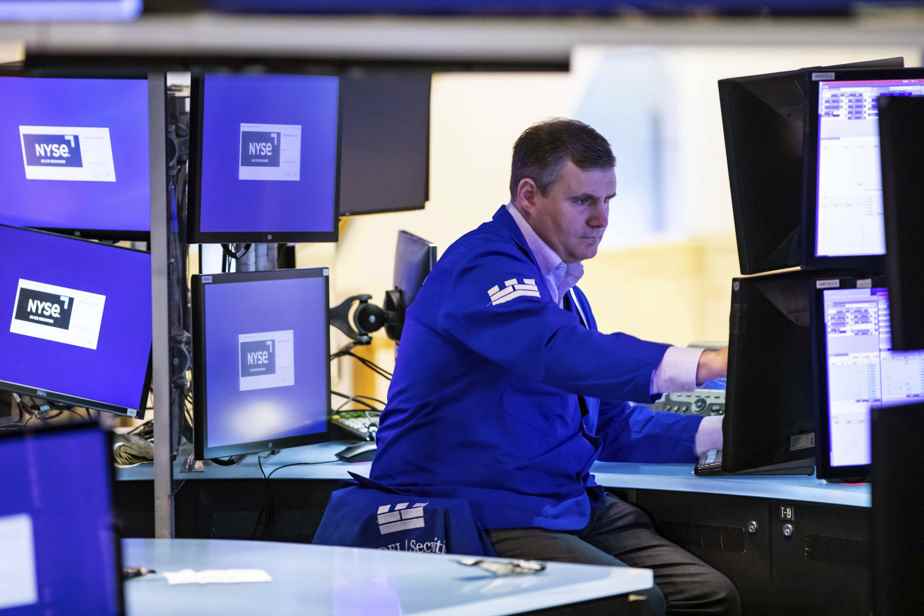(New York) The New York Stock Exchange ended the week lower on Friday, nevertheless managing to limit its losses thanks to a technical rebound, even if investors remain gloomy.
Updated yesterday at 5:02 p.m.
The Dow Jones lost 0.30%, to end at 32,899.37 points, the NASDAQ index fell 1.40%, to 12,144.66 points, and the broader S&P 500 index lost 0.57. %, at 4123.34 points.
After experiencing its worst session since 2020 on Thursday, the New York market initially seemed set to relive a nightmare at the start of the session, with the NASDAQ dropping up to 2.65%.
The index with a strong technological flavor even briefly fell below 12,000 points for the first time in 16 months, posting a loss of more than 26% since its peak last November.
Peter Cardillo, of Spartan Capital, had warned that the indices were approaching, on the downside, important technical thresholds and were likely to find material for a rebound there. That’s what happened mid-morning.
“The mechanism worked and prevented prices from going lower,” said Karl Haeling of LBBW Bank. “But it might have been better if they had fallen 5% again,” like the day before.
For the analyst, this technical rebound reduces the likelihood that investors will consider the current levels as a floor and start buying again.
The monthly report on US employment, published before the stock market, did not help operators out of their gloom.
First seduced by the 428,000 job creations in April, better than expected, they then saw less encouraging elements.
The downward revision of 39,000 for the month of March thus tempered the April figure.
Moreover, economists have expressed concern about a slight decline in the labor force participation rate (ratio between people employed or looking for work and the population of working age), while the job market is already wrought up.
“There’s nothing in there that can steer the Fed one way or another,” concluded Chris Low of FHN Financial.
In the bond market, yields continued to rise, stimulated by the prospect that the main interest rate of the American central bank (Fed) will reach at least 3% by the end of the year, a scenario whose probability is 85% for operators.
The yield on 10-year US government bonds climbed to 3.14%, not far from 3.26%, which is the highest level in its last 11 years.
“Ultimately, the question is whether it is possible for monetary policy to bring inflation back to an acceptable rate without causing a long-term recession,” argued Karl Haeling.
Listed, Under Armor was tackled by investors (-25.88% to 9.85 dollars) after results and forecasts deemed disappointing. The sports equipment manufacturer anticipates a drop in its margins as well as a loss of growth of around 3 percentage points due to supply problems.
The publication came in conjunction with that of the German Adidas, which also suffered from confinements in China and lowered its margin objectives for the year.
These poor figures dented the entire sportswear sector, from Nike (-3.49%) to Lululemon (-7.73%).
The DoorDash meal delivery platform was penalized (-1.42% to 72.11 dollars) despite a turnover higher than expectations, investors dwelling on the continued deceleration of its growth, after vintages 2020 and 2021 boosted by the pandemic.
Difficult day also (-7.70% to 15.70 dollars) for the specialist in exercise bikes and connected treadmills Peloton, which would be looking for investors ready to take a minority stake of around 15 to 20 %, according to wall street journalto bail out the coffers of the group, currently in difficulty.
Sixth consecutive weekly decline in Toronto
North American stock markets ended a week of volatility on Friday losing more ground, as the latest labor market data reinforced the idea that central banks will continue their campaign of significant interest rate hikes.
The Toronto Stock Exchange’s S&P/TSX Composite Index returned 62.89 points to end the day with 20,633.28 points. He fell earlier in the session to 20,416.38 points. It was its sixth consecutive weekly decline, as Wednesday’s gains were more than offset by weakness in the last two sessions of the week.
In the currency market, the Canadian dollar traded at an average rate of 77.63 US cents, down from 77.99 US cents the previous day.
On the New York Commodities Exchange, crude oil prices rose US$1.51 to US$109.77 a barrel, while natural gas fell 74 cents US to $8.04 US per million BTU.
The price of gold rose US$7.10 to US$1882.80 an ounce and that of copper fell US$2.5 cents to US$4.27 a pound.
The Canadian Press
